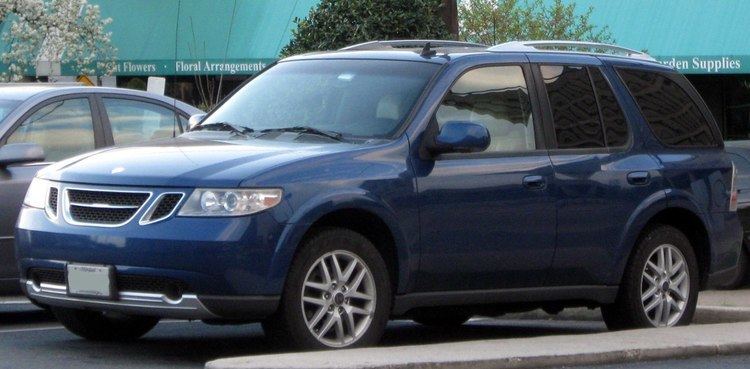Class Mid-size luxury SUV | Production 2005-2009 Body style 4-door SUV | |
 | ||
Assembly | ||
The Saab 9-7X is a mid-size luxury SUV built by Saab on General Motors' GMT360 platform, which also includes the GMC Envoy, Buick Rainier, Oldsmobile Bravada, Isuzu Ascender, and Chevrolet TrailBlazer.
Contents
The 9-7X was the first American-built Saab. It was assembled in the same United States Moraine, Ohio, production plant as the other GMT360 SUVs and shared many components with its platform mates. The Saab 9-7X succeeded the Oldsmobile Bravada as GM's flagship mid-size SUV, and was GM's highest priced mid-size SUV. Two first prototypes be made in mid-2002 but still on standart Oldsmobile Bravada chassis without any changes. In fall 2002 Saab Sweden begin work on ,,more Saabish feel" on the car and build team around Per Jansson who make this changes. Most bodyshell was shared with the Bravada, yet its exterior was distinguished by its front fascia, headlamps, hood, front fenders, roof rack, tail lamps, rear licence plate area, wheels, and rear bumper.
The Saab 9-7X was the last of the GMT360 SUVs. It was one of the first Saabs to feature standard all-wheel drive, along with the Saab 9-2X. It was the only GMT360 SUV not available with rear-wheel drive. The 9-7X was the first production Saab with a V8 engine. It also featured substantial chassis revisions, including a 1-inch (25 mm) lower ride height, revised bushings and dampers, and quicker steering to sharpen the handling. Like the Oldsmobile Bravada and Buick Rainier, it featured standard rear air suspension. The interior design was inspired by the Saab 9-5 with features like the console-mounted ignition switch and swing-out cup holder retained. Missing were the "night panel" switch that extinguished all unnecessary dash lighting, as well as the Saab active head restraints.
The GMT360 platform and the 9-7X were not scheduled to be updated or continued after the 2009 model year. Its position in the Saab lineup was eventually to be occupied by the Subaru B9 Tribeca-based Saab 9-6X. However, GM divested its Subaru stock, leading to the 9-6X development being cancelled, giving the Tribeca an early face-lift as the 9-6X exterior was less controversial. Instead, the position was filled by the Theta-based 9-4X, which was produced in 2011.
According to the GM Fleet website, the 9-7X, along with its platform mates, the Chevrolet TrailBlazer and GMC Envoy were to remain in production for the entire 2009 model year. However GM closed the Moraine plant on December 23, 2008. The decision to close came early in the 2009 model year as sales continued to decline throughout the North American SUV segment. Sales of the 9-7X declined 30 percent in the first nine months of 2008. Envoy and Trailblazer sales declined 44 percent and 37 percent respectively.
The 9-7X should not be confused with the Saab 97 (Saab Sonett II and III) produced from 1966 to 1974.
Variants
All 9-7Xs featured automatic all-wheel drive with a rear limited-slip differential. In addition to the rear limited-slip differential, the Aero model is equipped with a Torsen center differential. All 9-7Xs include leather seats, 18-inch (460 mm) or 20-inch (510 mm) alloy wheels, and side-curtain airbags. Entertainment and convenience features included OnStar, XM Satellite Radio, a 6-CD 6-speaker 275 Watt Bose audio system, StabiliTrak (from MY2006), optional DVD-based navigation system (from MY2006 up), and either a moonroof or a rear-seat DVD entertainment system. (From MY2006 up, those two options could be combined) Like other Saab models, there were two named variants in 2005:
Markets
Although the Saab 9-7X was developed for the North American market, the model was also sold in many other countries: Sweden, Bulgaria, Chile, Estonia, Greece, Hungary, Italy, Jordan, Kuwait, Latvia, Lebanon, Netherlands, Oman, Qatar, Saudi Arabia, Syria, and the United Arab Emirates.
Recall
In 2012, General Motors and Isuzu recalled more than 258,000 SUVs in the U.S. and Canada to fix short-circuits in power window and door lock switches that could cause fires. The recall covered Chevrolet TrailBlazer, GMC Envoy, Buick Rainier, Isuzu Ascender and Saab 9-7X SUVs from the 2006 and 2007 model years. The SUVs were sold or registered in 20 U.S. states, Washington, D.C., and Canada, where salt and other chemicals are used to clear roads in the winter.
Recalls was made due to fire in the vehicle. Moisture entered through the door and caused the issue, in 2008, the electrical system in the doors were now covered in plastic to protect them.
